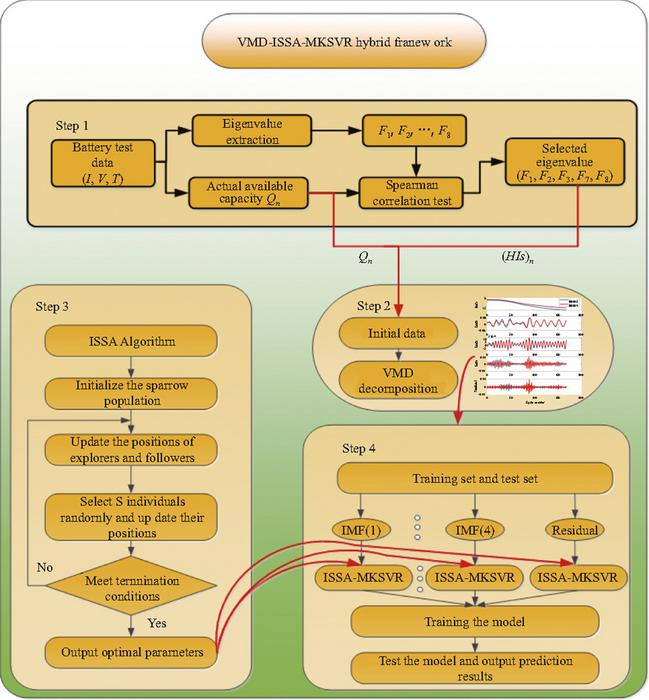A paper proposing a hybrid data driven framework considering feature extraction for battery state of health estimation and remaining useful life prediction was published in the journal Green Energy and Intelligent Transportation on 29 March 2024.

Credit: GREEN ENERGY AND INTELLIGENT TRANSPORTATION
A paper proposing a hybrid data driven framework considering feature extraction for battery state of health estimation and remaining useful life prediction was published in the journal Green Energy and Intelligent Transportation on 29 March 2024.
VMD is used for completely non-recursive modal variation to deal with signals. The optimal solution of the variational problem is obtained finally by effective decomposition component of the given signal. By iteration, the VMD algorithm can decompose the signals into some intrinsic mode functions (IMFs) and a relevant residual value containing multiple different frequency scales.
SVM algorithm based on statistical learning theory was proposed by Vapnik, mainly used for pattern recognition and classification. Based on the VC dimension theory, SVM obtains the global optimal solution. To reduce the parameter dimension, the optimization process is simplified by introducing the kernel function. When used as a regression tool, SVM implements a variant of the algorithm called SVR.
The SSA algorithm is a new type of swarm intelligence optimization algorithm, and its basic structure is similar to ABC algorithm except the search operator. In this paper, it is used to optimize penalty constant C and Kernel function parameter σ to realize the accurate prediction of MKSVM model.
Elite chaotic opposition-learning method is adopted to generate an initial population to enhance its quality and diversity. By selecting elite individuals on a larger scale, the algorithm can improve the local escape ability and convergence performance, then lead to a more accurate solution. In this paper, the chaotic skew tent map is chosen to generate the initial population to enhance the stability of the initial individuals due to its characteristic of randomness and ergodicity.
Since the update weight is large and not changed much during iteration, it may miss the global optimum. Adaptive weights are introduced to improve the performance of SSA algorithm to find the global optimum.
In this study, researchers present a hybrid framework considering feature extraction for a better performance of battery SOH estimation and RUL prediction. The hybrid framework combining VMD, improved sparrow search algorithm (ISSA) and multi-kernel support vector regression (MKSVR) model. The contributions are summarized. First, eight features are obtained to fed into the life prediction model by feature extraction. Secondly, VMD method is applied to decompose the original data to make the capacity data more stable. Then, elite chaotic opposition-learning strategy and adaptive weights are adopted to optimize the traditional sparrow search algorithm (SSA) to obtain more accurate parameters of the prediction model. Finally, MKSVR is used to solve the low prediction accuracy problem caused by large sample data and uneven distribution of high-dimensional feature space.
Dataset from National Aeronautics and Space Administration are applied for experimental verification. The RUL predictions with different start points are conducted to verify the stability of the VMD-ISSA-MKSVR framework. By comparison with IPSO-SVR, ISSA-SVR, BL-ELM and VMD-ISSA-SVR, it can be verified that the errors of SOH estimation and RUL prediction obtained by the VMD-ISSA-MKSVR framework are the smallest. It has relatively high prediction accuracy and stability.
###
Reference
Authors: Yuan Chen a, Wenxian Duan b, Yigang He c, Shunli Wang d, Carlos Fernandez e
Title of original paper: A Hybrid Data Driven Framework Considering Feature Extraction for Battery State of Health Estimation and Remaining Useful Life Prediction
Article link: https://doi.org/10.1016/j.geits.2024.100160
Affiliations:
aSchool of Artificial Intelligence, Anhui University, Hefei 230009, China
bState Key Laboratory of Automotive Simulation and Control, Jilin University, Changchun 130022, China
cSchool of Electrical Engineering and Automation, Wuhan University, Wuhan 430000, China
dSchool of Information Engineering, Southwest University of Science and Technology, Mianyang 621010, China
eSchool of Pharmacy and Life Sciences, Robert Gordon University, Aberdeen, AB10-7GJ, UK
Journal
Green Energy and Intelligent Transportation
DOI
10.1016/j.geits.2024.100160
Method of Research
Experimental study
Subject of Research
Not applicable
Article Title
A hybrid data driven framework considering feature extraction for battery state of health estimation and remaining useful life prediction
Article Publication Date
29-Mar-2024
COI Statement
The authors declare that they have no known competing financial interests or personal relationships that could have appeared to influence the work reported in this paper.




